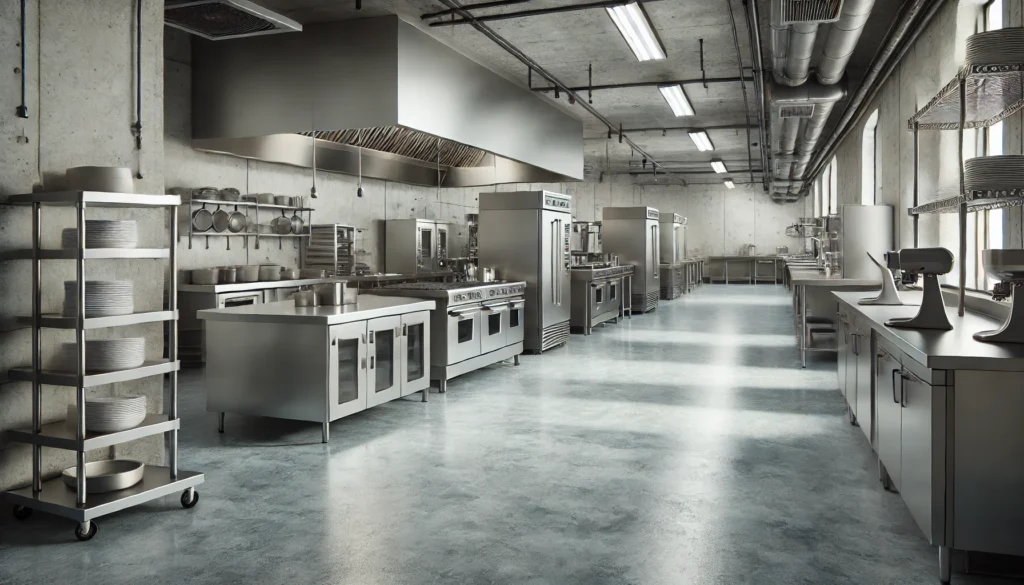In a fast-paced city like New York, where first impressions and operational efficiency are key, your flooring choices can be critical. They define your business space’s aesthetic and functionality. From sleek showrooms to bustling kitchens, the right flooring can significantly reduce maintenance costs and enhance customer experience. It also ensures long-term durability. Below, we’ll explore three proven flooring solutions—polished concrete, epoxy-coated concrete, and urethane cement. These solutions are ideal for high-traffic areas, and we provide real-world examples to back up their benefits.
Polished Concrete: Modern, Durable, and Eco-Friendly
Polished concrete has transformed from an industrial flooring option into a stylish, sophisticated choice for high-traffic commercial spaces. Its durability and aesthetic flexibility make it appealing for businesses looking for floors that look great and withstand heavy foot traffic.
- Example: The retail giant Apple uses polished concrete floors in many flagship stores, including the iconic Fifth Avenue store in NYC. These floors aren’t just chosen for their sleek, modern appearance. They handle the enormous daily foot traffic without showing signs of wear. Plus, polished concrete’s reflective surface helps maximize natural light. This makes the store’s interior brighter and more welcoming while reducing energy costs.
- Why it Works: Polished concrete is nearly indestructible when adequately installed and treated. It doesn’t require waxing, and because it’s highly resistant to stains and abrasions, it minimizes your need for costly maintenance. If sustainability is part of your business ethos, polished concrete is a greener choice. It repurposes existing concrete slabs, reducing the need for additional materials.
- Bonus: By opting for a polished concrete finish, you also reduce the amount of artificial lighting needed. The floor’s reflective surface can improve ambient lighting by up to 30%. This offers savings on electricity bills while making your space look brighter and more appealing to customers.

Epoxy-Coated Concrete: Tough, Seamless, and Customizable
Epoxy-coated concrete flooring is perfect for businesses looking for a robust, durable, and customizable solution. This type of flooring involves applying epoxy resin layers over concrete. This creates a seamless, easy-to-clean surface that can withstand heavy use, chemicals, and spills.
- Example: The JetBlue hangar at JFK International Airport uses epoxy-coated concrete for its heavy-duty flooring needs. The hangar floor must support not only the weight of large aircraft but also exposure to fuel spills, oils, and cleaning chemicals. Epoxy flooring in high-stress environments shows its ability to resist damage and stains. It also offers an easy-to-clean surface.
- Why it Works: Epoxy-coated floors resist heavy loads, making them ideal for retail stores, garages, and warehouses. Their seamless surface reduces the risk of bacteria or dirt getting trapped, making them a smart option for businesses that need to maintain high hygiene standards, like restaurants or healthcare facilities. Additionally, epoxy coatings can be customized with colors, patterns, and textures. This creates a unique look that reflects your brand while offering slip resistance in areas prone to spills.
- Bonus: Epoxy coatings can last 10-20 years, depending on usage, and their installation time is relatively quick compared to other solutions. This means less downtime for your business during renovation.
Urethane Cement: The Best for Kitchens and Food Service Areas
Urethane cement is the industry standard for commercial kitchens or food preparation areas because of its unparalleled durability in harsh environments. It can withstand rapid temperature changes, heavy equipment, and constant exposure to moisture and chemicals. This makes it a wise long-term investment.
- Example: The Shake Shack headquarters kitchen in NYC uses urethane cement for its flooring due to its resilience in handling daily kitchen activity. This includes everything from high-temperature cooking to frequent spills of grease and oils. Urethane cement ensures the kitchen floor remains intact and easy to clean after years of heavy use.
- Why it Works: Urethane cement is thermally stable and can withstand the extreme heat from ovens and grills. It also handles the cold temperatures of walk-in freezers. Its natural resistance to moisture prevents the growth of mold and bacteria, which is crucial for maintaining hygiene in food service environments. Additionally, its textured surface helps reduce the risk of slip-and-fall accidents, common in busy kitchens.
- Bonus: Urethane cement’s longevity is unmatched. While epoxy flooring may need touch-ups or resealing after several years, urethane cement can last even longer with minimal maintenance. It is the ultimate solution for high-stress areas like restaurant kitchens.

The Business Case for Durable Flooring: Cost, Aesthetics, and Long-Term Savings
NYC’s bustling business environment demands solutions that are not only attractive but also robust and cost-effective. By investing in durable flooring options like polished concrete, epoxy-coated concrete, or urethane cement, you choose materials that meet the city’s fast-paced, high-traffic demands.
- Cost Efficiency: These flooring solutions are designed to withstand heavy use, reducing the need for frequent repairs or replacements. Although the initial investment may be higher than traditional flooring materials, the long-term savings in maintenance and replacements far outweigh the upfront costs.
- Aesthetic Appeal: Whether you’re aiming for a modern, industrial-chic look with polished concrete or want a vibrant, branded floor with customized epoxy, these materials offer flexibility in design that can enhance the overall look and feel of your business space.
- Increased Longevity: In a city where downtime means lost revenue, minimizing disruption is vital. Durable flooring solutions ensure fewer interruptions for repairs, meaning your business can keep running smoothly with minimal disruption.
Key Takeaways:
- Polished Concrete: Offers durability, eco-friendliness, and a sleek, modern appearance that elevates your space while reducing maintenance costs. It is ideal for retail and public-facing areas.
- Epoxy-Coated Concrete: Provides a seamless, chemical-resistant, and customizable solution, perfect for high-traffic environments that need a hygienic, resilient surface.
- Urethane Cement: This is the best option for commercial kitchens, food prep areas, or any space with extreme temperature fluctuations, heavy equipment, and high moisture exposure.
By choosing the right flooring for your NYC business, you’re not just improving the look and feel of your space—you’re investing in its future. These durable flooring solutions enhance your business’s efficiency, safety, and appeal while keeping costs down in the long run.
